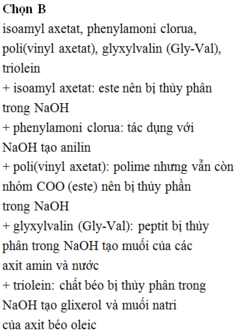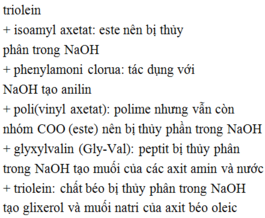Hãy nhập câu hỏi của bạn vào đây, nếu là tài khoản VIP, bạn sẽ được ưu tiên trả lời.

Đáp án D
isoamyl axetat, phenylamoni clorua, poli(vinyl axetat), glyxylvalin (Gly-Val), triolein
+ isoamyl axetat: este nên bị thủy phân trong NaOH
+ phenylamoni clorua: tác dụng với NaOH tạo anilin
+ poli(vinyl axetat): polime nhưng vẫn còn nhóm COO (este) nên bị thủy phần trong NaOH
+ glyxylvalin (Gly-Val): peptit bị thủy phân trong NaOH tạo muối của các axit amin và nước
+ triolein: chất béo bị thủy phân trong NaOH tạo glixerol và muối natri của axit béo oleic

Đáp án A
Isoamyl axetat, phenylamoni clorua, polivinylaxxetat, Gly-Ala, triolein

Chọn A.
Chất tác dụng được với dung dịch NaOH đun nóng là isoamy axetat, phenylamoni clorua, poli(vinyl axetat), glyxylvalin, triolein

Các chất bị thủy phân gồm có saccarozơ, isoamyl axetat, phenyl fomat, glyxylvalin (Gly-Val), triolein
=> Đáp án A

Chọn đáp án A
Số chất bị thủy phân trong môi trường axit, đun nóng gồm:
saccarozơ, isoamyl axetat, phenyl fomat,
glyxylvalin (Gly-Val), triolein.

Chọn C.
Các chất đó là: isoamyl axetat, phenylamoni clorua, Gly-Val, triolein



Đáp án D
Số chất có khả năng tác dụng với NaOH đun nóng là:
Isoamyl axetat, phenylamino clorua, poli(vinyl axetat), Gly-Val và triolein